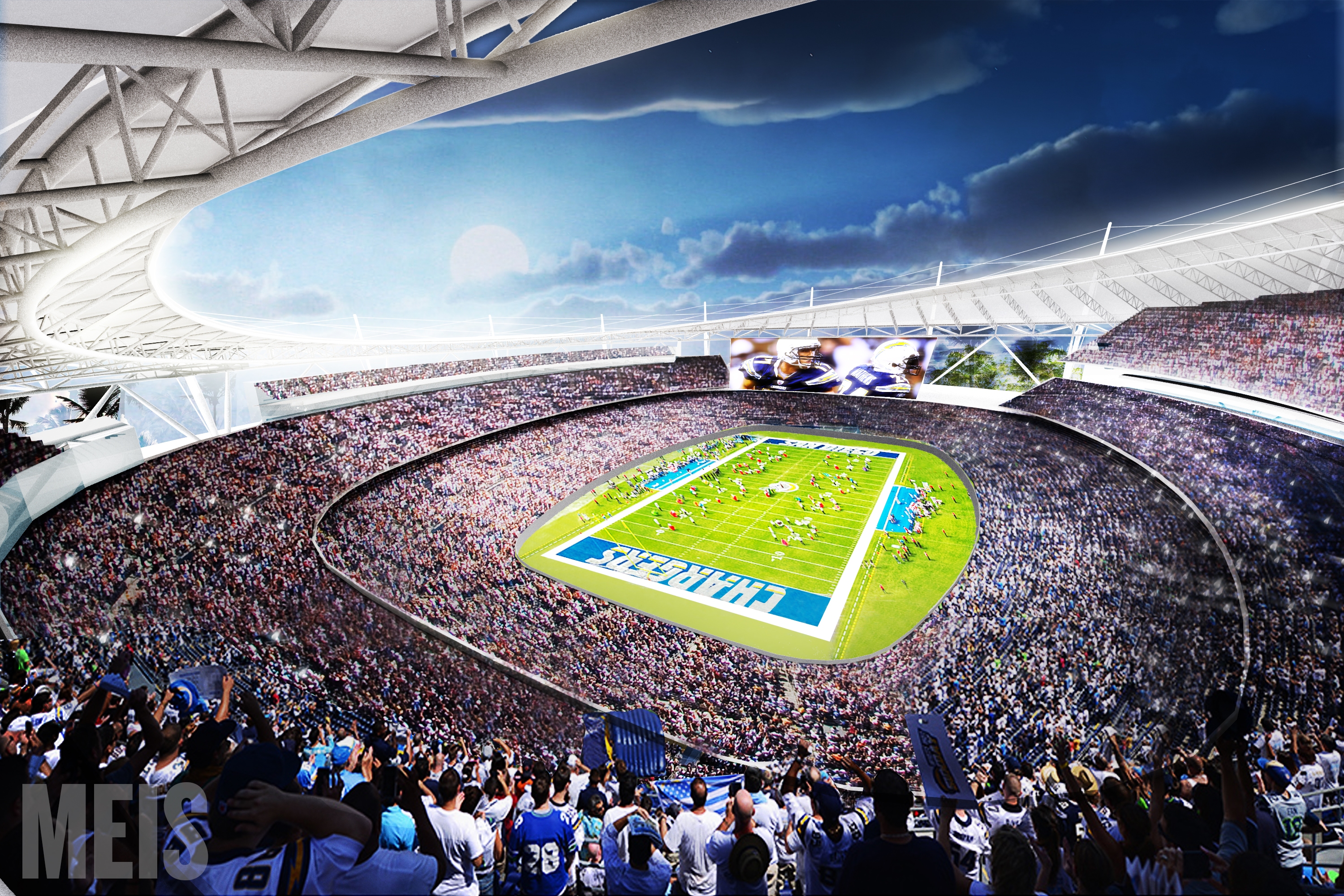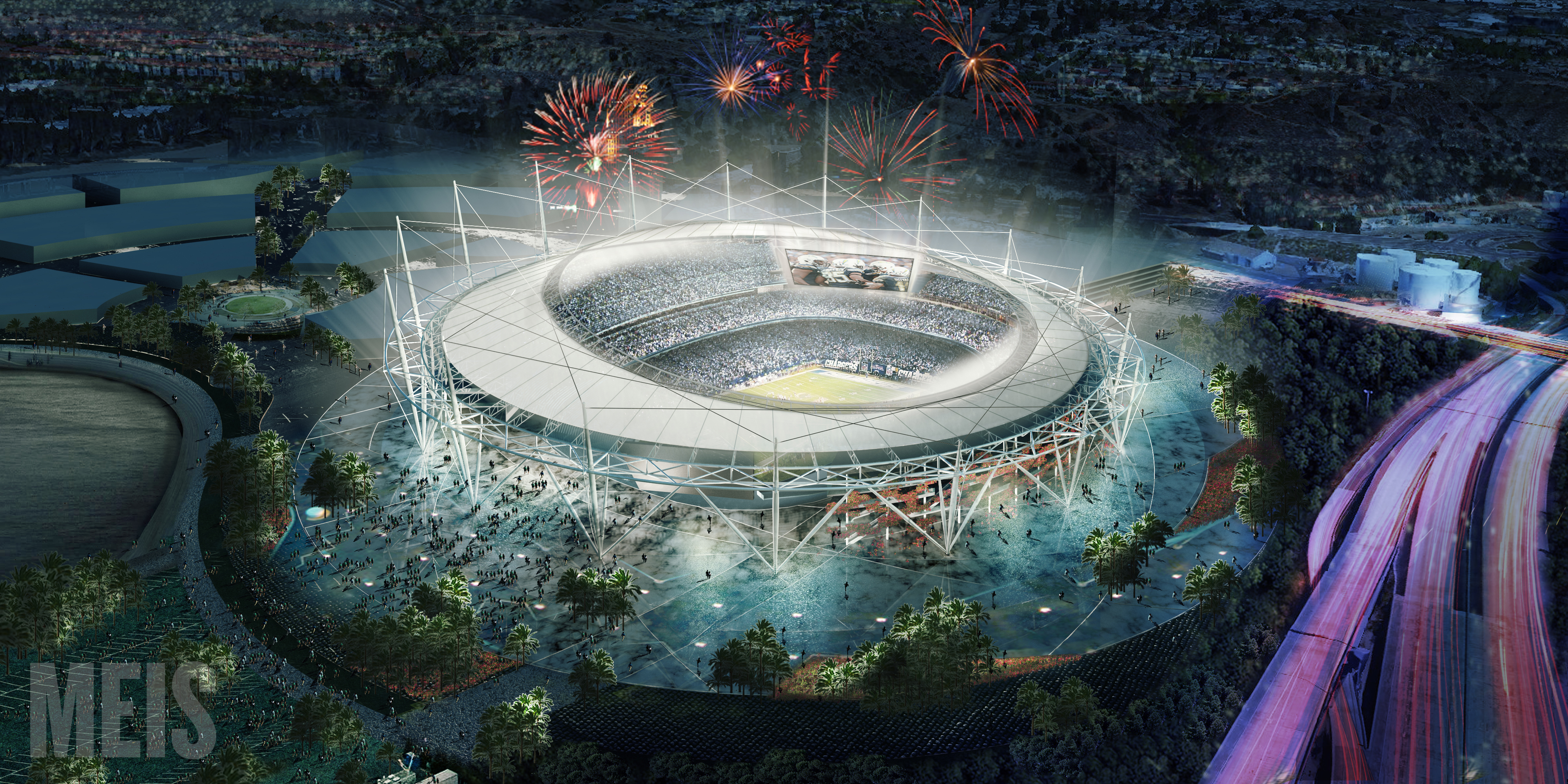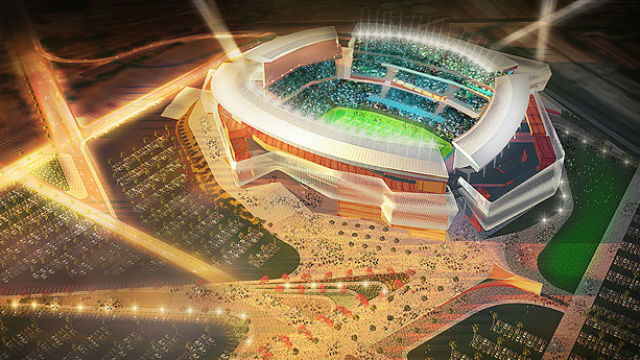Stadium Financing Plan Unveiled
Included in CSAG’s plan is a $1.1 billion proposed stadium designed by MEIS, a New York-based stadium design firm, that would take advantage of San Diego’s sunny and mild year-round climate.
Citizens’ Stadium Advisory Group Outlines
$1.1 Billion Multi-Use Stadium and Financing Plan
Mayor Kevin Faulconer’s Citizens Stadium Advisory Group (CSAG) has released its “Site Selection and Financing Plan for New Multi-Use Stadium in San Diego”
:It lays out a clear and workable path to a new multi-use stadium that is fair for everyone, including taxpayers,” the panel said in its report.
“We developed a financing plan that would actually succeed in this unique San Diego environment, ensuring that it is fair for the Chargers and other tenants, fair for the City and County, and fair for taxpayers,” CSAG Chairman Adam Day said. “Our plan is the first of its kind, and it should jump-start negotiations between the Chargers, the city, and the county. There now is a fair and workable path to a new stadium in San Diego.”
CSAG concluded a new multi-use stadium in Mission Valley is the most viable option, and would cost approximately $1.1 billion, excluding land. To pay for the facility, CSAG outlined more than $1.4 billion in revenue streams without increasing taxes.
After years of no progress due to the pension crisis, the Great Recession and other factors, CSAG’s blueprint is an important break from the past and the latest in a series of positive steps that, for CSAG, began 108 days ago.
Several San Diego leaders, including former Chargers, are praising CSAG’s plan.
“This financing plan is an important milestone and creates the framework needed to begin negotiations,” said Jerry Sanders, president & CEO of the San Diego Regional Chamber of Commerce. “CSAG has done a remarkable job under intense pressure and a tight deadline. Now it’s time to support our Mayor and the County in their negotiations with the Chargers.”
Faulconer announced the formation of the Citizens’ Stadium Advisory Group on Jan. 30, to chart a workable path to building a new multi-use stadium in San Diego that protects taxpayers and creates a win-win solution for the Chargers and San Diego.
“San Diego is where I grew up as a man, husband, father and a football player,” former Charger LaDainian Tomlinson said. “CSAG’s plan is the first chance the community has had to solve a problem that has existed since I first arrived in 2001. I hope the city, county and the Chargers use this plan as a basis to retain the team in the community it belongs.”
Former Charger Nick Hardwick said: “I’m excited about the proposal that CSAG has put forth for a new stadium in San Diego. It appears thoughtful and achievable and gives America’s finest city its best chance to attain a tremendous civic asset. Mostly I’m encouraged that all parties are concerned with legacy: legacy of the Chargers; legacy of the men who played over the years wearing the Lightning Bolt on their helmets; and the amazing generations of Chargers’ fans who have supported the team through good times and bad.”
To pay for the proposed stadium, parking, stadium-related infrastructure and operations and maintenance, CSAG’s financing plan includes 60 acres of land from the city of San Diego valued at $180 million, and more than a dozen funding sources that exceed $1.4 billion, including:
• $300 million from the Chargers
• $173 million in bondable construction capital from the team’s rent
• $200 million from the NFL
• $121 million from the County of San Diego
• $121 million from the City of San Diego
• $225 from the sale of 75 acres of land
• More than $100 million from fans, who would contribute through the purchase of Personal Seat Licenses (PSLs), and ticket and parking surcharges

Included in CSAG’s plan is a $950 million proposed stadium designed by MEIS, a New York-based stadium design firm, that would take advantage of San Diego’s sunny and mild year-round climate.
Stadium design veteran Dan Meis is the founder and managing principal at MEIS. He was the lead designer for the Staples Center in Los Angeles and two existing NFL stadiums — Paul Brown Stadium in Cincinnati and Lincoln Financial Field in Philadelphia. MEIS currently is working on renovations at Paul Brown Stadium and designing a new 60,000-seat soccer stadium in Rome, Italy called “Stadio Della Roma” that includes a mixed-use entertainment village similar to “LA Live” at Staples Center.
“Unlike major league baseball that has been so successful in developing stadiums that are well integrated and evocative of their locations — Camden Yards in Baltimore, AT&T Park in San Francisco — NFL stadiums have been, for the most part, fairly generic architecturally,” Meis said. “We believe the design we created for the proposed stadium in San Diego will alter that trend by presenting a venue that truly embodies the city’s landscape and spirit.”
Working alongside Meis on the proposed stadium was Xan Young, senior project designer with MEIS.
“A stadium’s purpose is only realized with fans inside; likewise, people truly become spectators only when experiencing an event in a shared venue. This mutual benefit is never more true than it is in San Diego, where the open air quality allowed by the mild and sunny weather allows for a seamless transition between outside and in, and a premium viewing experience that is both refined and accessible to everyone,” Young said. “Some venues take years to take on the character of the fans that most define it. This one will feel like home to San Diego from the day it opens,” she said.
In addition to the stadium, CSAG’s research led it to estimate that parking and stadium-related infrastructure would cost $204 million. The state-of-the-art venue would be home to the Chargers, San Diego State Aztecs, the Holiday and Poinsettia Bowls, and numerous other events – from corporate events to rodeos – that would help pay for operations and maintenance.
CSAG released its financing plan at a news conference at the San Diego County Operations Center/Campus Center Chambers.
“From the beginning of this process you could tell this time was different, and CSAG’s plan confirms that,” said Rafael Alvarez, who heads Bolt Pride and helps lead Save Our Bolts, which represent more than 20,000 Chargers’ fans. “I congratulate CSAG for its commitment to this process and for delivering a fair and workable stadium plan. Now it’s time for the Chargers, the City and the County to finish what CSAG started. The Chargers belong in San Diego.”
As for the site selection, CSAG’s report says without Mission Valley a clear path to a stadium would not exist in San Diego.
“Given the accelerated timeline the NFL and the Chargers established, the Mission Valley site emerged as the only option that leads to a ribbon cutting ceremony at a new stadium before the end of the decade,” CSAG’s report said.
The city and the city’s Water Department own the land, valued at $180 million, and the 166-acre site has tremendous potential. CSAG also examined a Downtown location, which proved to be unworkable for a variety of reasons outlined in the report.
“If one were to move the proposed Mission Valley stadium Downtown, where the city does not own any land for a stadium, it would increase hard costs by at least a quarter billion dollars,” the report said. “The city would have to buy multiple parcels of land and pay to relocate and clean a large bus yard, a process expected to take up to 7 years.”
The report adds: “For CSAG, the Downtown plan eventually became a non-starter because it relies on a tax increase of at least $600 million that would require support from two-thirds of the voters. Numerous polls have shown San Diego voters would soundly reject such a tax increase.”
In addition to explaining how the Chargers, the city and the county would recoup construction costs, CSAG’s plan incudes a series of next steps and recommendations that explain what’s ahead and what’s needed.
“For reasons outlined in this report, a path to a new multi-use stadium in San Diego exists,” the report concludes. “A collaborative effort is needed to build on the momentum San Diegans have created. CSAG would encourage everyone to put San Diego first. If we do, we will achieve greatness, and our new stadium will be a constant reminder of what we can achieve together.”



